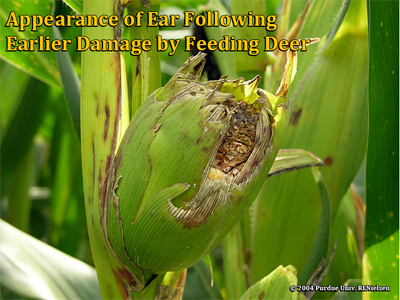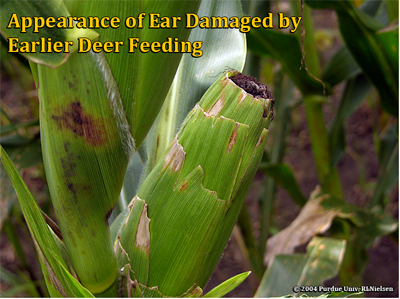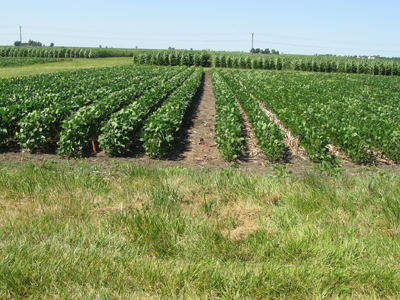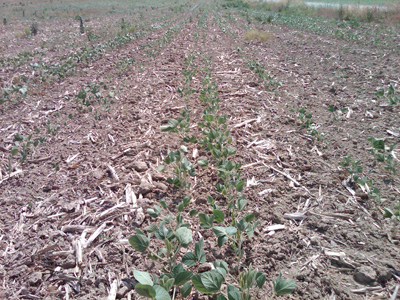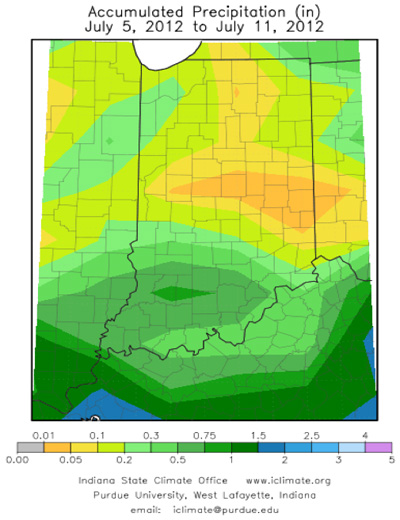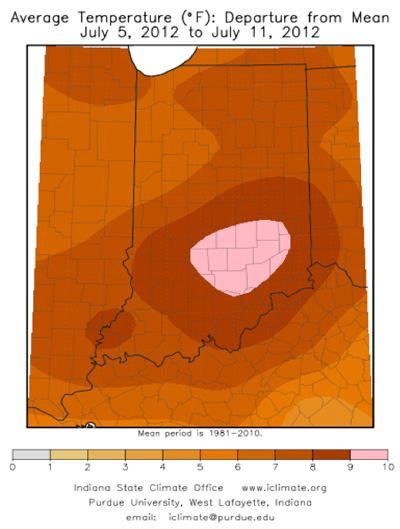Pest & Crop Newsletter, Entomology Extension, Purdue University
Spider Mite Infestations More Evident, What is the Impact of Rain? – (Christian Krupke and John Obermeyer)
• Wishing you abundant rainfall…soon!
• Rainfall has little direct impact upon spider mites – it does not kill them.
• Rainfall does encourage plant growth and vigor – this is the key to reducing mite reproduction.
• Depending on future weather, rain may provide a brief respite from spider mite damage and spread.
Forecasts that include a 50% chance of rain for the next few days bring the prospect of some relief, but more is needed. What about rain and spider mites – does rain actually control mites or reduce their populations? Before attempting to answer the question, let’s review the factors that come together to create a spider mite problem in soybean fields.
Extended hot and dry conditions will:
1) encourage the movement of spider mites from brown and drying field margins (especially roadside areas) to soybean and other crops.
2) favor very rapid (explosive!) reproduction of spider mites because the stressed plant provides an ideal source of nutritious fluids (including protein that can be used for egg production).
3) dramatically reduce fungal pathogens that help keep spider mites in check under “normal” conditions
A significant rainfall (1” or more) followed by high humidity will:
1) hydrate the plant, making it less conducive for spider mite population growth. In other words, spider mite reproduction slows down dramatically.
2) encourage the growth, development, and dissemination of beneficial fungal pathogens that reduce mite populations
Remember, rain does not make the spider mites go away, it just slows down their reproduction and makes soybeans much less hospitable as a food source. They are always present in and around every soybean field in the state. They just remain a non-pest until weather is hot and dry for an extended period. If mites are an issue in a field, don’t delay treatments - remember that spider mite damage is irreversible. We are entering a critical period of soybean growth and development; brown leaf will not “turn green” once mites are gone, and brown leaves contribute nothing to yield. Refer to Pest&Crop #12, June 15, 2012 for further spider mite information and control products.
Death and bronzing of soybean plants on the field border from spider mite feeding and spread
![]()
Click here for the Blacklight Trap Catch Report
![]()
Click here for the Western Bean Cutworm Trap Report
Drought Impacts on Weed Science – (Travis Legleiter and Bill Johnson)
As the drought in Indiana progresses many producers may be contemplating chopping drought stressed corn for silage to supplement a shortened livestock feed supply. While the Purdue Animal Sciences group has done an outstanding job of getting information to producers regarding nitrate levels in silage and the dangers of chopping drought stressed corn producers need to also keep in mind the herbicide pre harvest intervals (PHI). All herbicides applied to corn will have a labeled interval in which producers must wait following application before harvesting for forage or grain. These intervals are designed to protect the end users, livestock consuming the silage or grain, from potential herbicide residues left in the corn plant. The majority of herbicides have a PHI of 30 to 60 days and should not be an issue if applied pre-emergence or early post, there are a few with longer intervals that may have potentially been applied mid to late post. The following link is a table extracted from the Ohio and Indiana Weed Control Guide with grazing and forage intervals for corn herbicides: <https://ag.purdue.edu/btny/weedscience/Documents/Corn_PHI_Silage_grazing.pdf>
Livestock producers who are experiencing grass shortages in pastures due to the drought conditions also need to keep toxic weeds in mind. These poisonous species may exist regularly in pastures, but are typically avoided by livestock due to their lack of palatability. Though under drought conditions with a shortage of favorable grass and forage, livestock may be forced to graze these toxic plants. A list a description of toxic weeds can be found in the Guide to Toxic Plants in Forages <http://www.extension.purdue.edu/extmedia/WS/WS_37_ToxicPlants08.pdf>. For a list of other toxic weed links go to the poisonous weeds tab on the Purdue Weed Science Website <https://ag.purdue.edu/btny/weedscience/Pages/PoisonousPlants.aspx?>
Scout Soybean Fields for Charcoal Rot – (Kiersten Wise and Terri Hughes)
Few diseases thrive under the hot, dry weather that we are experiencing in Indiana this year. However, there has been some concern about the potential impact of charcoal rot in soybeans. Charcoal rot, caused by the fungus Macrophomina phaseolina, infects seedlings early in the growing season yet symptoms may not appear until mid-season or later. This fungus spreads from the roots to the stem, filling tissues with dark, round fungal structures called microsclerotia (Figure 1). These structures clog vascular tissue, causing wilting, yellowing, and stunting of the plant, which is especially apparent in drought stressed areas.
Charcoal rot will be hard to diagnose in years like 2012, since it is difficult to distinguish it from symptoms of general drought stress. Plants on hillsides or sandy areas will typically exhibit symptoms first. To determine if charcoal rot is present, pull symptomatic plants and split the lower stems to look for a gray discoloration (Figure 2) and/or the presence of microsclerotia.
It is important to determine if charcoal rot is present because microsclerotia can survive in soil for several years and the fungus can infect a number of crops, including corn, which limits the effectiveness of tillage and rotations for managing the disease. Foliar fungicides are also ineffective at preventing or reducing disease development. Genetic resistance is limited, but may be available. Producers with confirmed fields of charcoal rot should work with seed dealers to select less susceptible varieties and avoid planting at high populations to reduce competition for water among plants.
Figure 1. Black fungal sgtructures called microsclerotia can be found in stem tissue infected by the fungus that causes charcoal rot.
Figure 2. Gray discoloration of stems is symptomatic of charcoal rot.
![]()
Distinguishing Goss’s Wilt from Drought Stress in Corn – (Kiersten Wise and Gail Ruhl)
Goss’s wilt of corn, caused by the bacteria Clavibacter michiganensis subsp. nebraskensis, has not yet been confirmed in Indiana in 2012. However, several samples have been submitted to the Purdue Plant and Pest Diagnostic Lab (PPDL) with suspected symptoms of the disease. This disease has been problematic in Nebraska this year and was widespread in Iowa and parts of Illinois last year.
The bacterium that causes the disease survives in residue and some grassy weed species and infects corn plants through wounds. The diagnostic symptoms of Goss’s wilt include water-soaked lesions that have black “freckles” or specks on or surrounding the lesions (Figure 1). These lesions can be on any leaves of the plant and may be quite large on susceptible hybrids. Bacteria can also move onto the leaf surface and give the leaves a shiny appearance (Figure 2).
These lesions are very easy to confuse with the firing that is common and widespread across Indiana due to heat and drought stress. (Figure 3). Many fields in Indiana are also exhibiting symptoms of nutrient deficiency, which can cause a burn that may resemble lesions of Goss’s wilt. We have also seen leaves with firing that appear shiny, but yet do not have Goss’s wilt. Shiny areas on leaves can also occur due to honeydew excreted from corn leaf aphids. Secondary fungi that feed on dead, ‘scorched’ tissue may also be confused with the black ‘freckles’ associated with Goss’s wilt..
It is important to remember that this disease MUST be diagnosed with at least two methods: microscopic observation of bacterial streaming from symptomatic tissue, and confirmation of the causal bacteria using organism-specific tests. In-field testing is possible with an immunostrip test marketed by the company Agdia, Inc. (http://www.agdia.com/). However, there are limitations to these in-field tests, and it is not recommended to rely solely on a positive diagnosis based on immunostrips. Sample contamination can occur in the field, and samples may occasionally test positive with the strips when leaves are not actually infected with the Goss’s wilt bacterium. Because of the potential for these false positives, it is important that any sample that tests positive in the field for Goss’s wilt is sent to a diagnostic lab for additional microscopic observation. Plants that are not infected with the bacterium will not exhibit this bacterial streaming, and Goss’s wilt can be ruled out.
Make sure to accurately diagnose Goss’s wilt before deciding on management options. In-season management is limited and may not be warranted depending on the growth stage and yield potential of the crop. Fungicides are not recommended to use for management of Goss’s wilt since it is a bacterial disease. Management options include tillage and rotation to help reduce the bacteria population present in the field for the subsequent corn crop. Residue can harbor bacteria for years, and so it is important to choose a hybrid that is less susceptible to plant into fields with a history of the disease.
Figure 1. Black freckling associated with lesions of Goss's wilt of corn.
Figure 2. Bacterial ooze on leaves is a sign of Goss's wilt.
Figure 3. Drought-stressed plants can have large scorched areas of leaves, which can be confused with symptoms of Goss's wilt.
Decapitation of Corn Plants by Deer – (Bob Nielsen) -
White-tailed deer (Odocoileus virginianus) are among the common mammal pests of corn in Indiana. The sight of deer grazing in harvested fields for dropped ears of corn is quite common in the fall, but these animals are also attracted to corn fields at other times of the year and can leave permanently damaged plants in their wake.
Early in the growing season, deer will sometimes feed on the whorls or tops of young plants in mid- to late June (about leaf stage V10 or roughly 30 inches tall) when the immature tassel down in the whorl is 4 to 6 inches long. Rather than actually eat the whorl leaves, the deer are apparently drawn to the succulent, moist immature tassel. The result are decapitated plants whose young whorl leaves have simply been pulled out and (I can only imagine) the tassel somehow chewed out and eaten. The mostly intact whorl leaves are left behind on the ground along with the tell-tale evidence of hoof prints and deer scat. The decapitated plants usually survive and ear development will continue through pollination and on to maturity, though the ears are usually less than full size owing to the fact that most of the photosynthetic leaf area above the ears is missing.
Missing whorl leaves resulting from earlier deer feeding
Upper whorls of leaves laying on the ground
Recovery of decapitated plant; but only in terms of elongation of leaf sheaths below the damage
Decapitated plants resulting from earlier deer feeding
Appearance of ear following earlier damage by feeding deer
Appearance of ear damaged by earlier deer feeding
These animals are also attracted to corn fields at about the time kernels reach the milk stage or «roasting ear» stage of development (early to mid-August). The common symptoms resulting from deer feeding on corn at this stage of development are decapitated ears. The ear symptoms are sometimes mistaken for bird damage, but differ because of the distinct appearance of «cut» husks and missing ends of cobs resulting from the deer «chomping» off the ends of the ears. Bird damage (crows, blackbirds, etc) more typically results in shredded ends of husks and barren cob tips.
Fortunately, deer damage to corn is often limited to a few number of rows closest to wooded areas. However, small fields of corn completely surrounded by woodlots or forest areas can sustain significant whole-field damage by deer grazing in mid-August. Deer damage to plants or ears of corn during the grain filling period often encourages disease infection of the damaged plant tissue by common smut (Ustilago maydis) spores. This disease eventually develops into the ugly or beautiful (eyes of the beholder) mass of fungal tissue on damaged plant parts.
Related Reading
MacGowan, Brian, Lee Humberg, James Beasley, Travis DeVault, Monica Retamosa and Olin Rhodes, Jr. 2006. Corn and Soybean Crop Depradation by Wildlife. Purdue Univ,<http://www.extension.purdue.edu/extmedia/FNR/FNR-265-W.pdf> [URL verified July 2012].
White-tailed Deer (Odocoileus virginianus). 2012. Purdue University Wildlife Crop Damage Site.<http://www.agriculture.purdue.edu/fnr/cropdamage/wildlife/deer.htm> [URL verified July 2012].
![]()
Reflections on Relative No-till Soybean Performance in Drought Years - (Tony J. Vyn, Terry D. West, and Peter Kovacs)
Why are no-till soybeans growing so slowly in 2012? Shouldn’t crops in no-till fields be doing better than those in conventional-tilled fields when there is a drought? Doesn’t no-till help preserve soil moisture because crop residues on the surface lower the evaporation rate? Will the no-till soybeans recover?
Crop consultants and farmers (even dedicated long-term no-till farmers) have been asking such questions as drought conditions have persisted in Indiana. From experiences gained in over 30 years of no-till research, we acknowledge that crop responses to tillage in 2012 are unusual. Although we can’t predict final soybean yield outcomes, some reflections on these puzzling questions might help provide perspectives.
No-till soybean (full-season) generally established decent stands this spring across Indiana as long as they weren’t planted too shallow or too late. But soybean plants in no-till fields have often been about 30% shorter than conventionally tilled fields if the latter fields also had enough seedbed-zone moisture to establish near-normal plant densities. Data we collected this summer confirms no-till soybean was about 33% shorter (Table 1) than that after moldboard plowing. A picture from our long-term no-till plots near West Lafayette illustrates some of the dramatic differences in soybean heights between tillage systems planted on the same date (Figure 1). This slower growth rate is despite perfect planting conditions in April, very warm soils almost the whole spring, no flooding damage, exceptionally good stands, good nutrient management, etc. Within-field differences in plant heights have also been obvious when farmers have tilled the headland areas on their field edges while leaving the bulk of the fields untilled.
| Table 1. Tillage system impacts on soybean plant heights and final yields in “drought years” and average soybean yields in the last 10 years on a dark prairie soil near West Lafayette, IN. Tillage and crop rotation experiment initiated in 1975; data presented are for the corn-soybean rotation system. | ||||||
|---|---|---|---|---|---|---|
| Tillage System* | Plant Heights (inches) 8 Weeks After Planting | Soybean Yields (bu/acre in Specific Years | ||||
| 1988 | 1991 | 2012 | 1988 | 1991 | 2002-2011 | |
| Moldboard | 17.8 a** | 24.5 | 21.9 a | 46.5 a | 52.4 b | 59.1 a |
| Chisel Plow | 13.9 b | 24.7 | 18.8 b | 39.9 b | 56.6 ab | 54.7 b |
| No-till | 9.5 c | 25.1 | 14.6 c | 34.3 c | 59.3 a | 59.1 a |
| *Planting dates were May 12 in 1988, May 16 in 1991, and April 25 in 2012. Soybeans were in 30” rows in each of those years. Soybean plant populations were equal for tillage systems except in 1988 when frost damage in late May reduced the final stands in no-till. ** When letters following the numbers within columns are different, the numbers are significantly different at the 5% level of probability |
||||||
Figure 1. No-till soybeans (on right) are much shorter than conventionally tilled soybean (on left) for a corn-soybean rotation on June 27, 2012. Location: ACRE, West Lafayette, IN. Corn plots immediately behind these 2 soybean plots are in the identical tillage systems (©2012 Purdue Univ., T.J. Vyn
Other prominent drought years in Indiana were 1988 and 1991. Shorter soybean plants were also evident on these same no-till plots, relative to tilled plots, in 1988, but not in 1991 (Table 1). No-till soybean yields in 1988 were 26% below those after moldboard plowing (Table 1). However, no-till yields in 1991 were 13% higher than those after moldboard plowing. The effect of drought on relative soybean yield response to tillage system, therefore, is very dependent on the timing and the severity of drought. In 1988, drought in the West Lafayette area began very early and was alleviated in mid to late July (Figure 3). In 1991, there was ample moisture in April and May, and the drought was severe in June and July. The 1991 results illustrate that no-till soybean got off to a great start and likely suffered less from a mid-season drought that year because early root elongation was not restricted by hard, dry soils. Unfortunately, the 2012 precipitation patterns for this location are more similar to 1988 than they are to 1991, while the accumulated GDD to July 10 suggests that 2012 has been even warmer than 1988 (Figure 4).
Figure 2. Resistance to soil penetration in no-till versus tilled (fall chisel plow plus spring secondary tillage) soils on April 26, 2012 when volumetric soil moisture in no-till soils averaged 21% versus 18% in conventional tillage in the top 4" of soil. Penetrometer resistance here was determined in the row after planting for a corn-soybean rotation at West Lafayette, IN.
Figure 3. Precipitation (inches per month) for the spring and summer of 1988, 1991 and 2012 (to the end of June) for West Lafayette, IN. Data courtesty of Indiana State Climate Office."
Much of the suppressed growth in no-till this year may be explained by soil resistance to root penetration being much higher in the top 6-8” of no-till fields (Figure 2) following a wet fall and a warm winter with almost no freeze-thaw loosening. Higher apparent soil compaction seems to be the case whether there was a lot of wheel-track damage, or even where we used RTK guidance to avoid wheel track compaction. Soil resistance to root penetration is always worst when soils are dry, but the higher resistances this spring in no-till occurred even when the no-till soils were initially wetter than those in conventional tillage. But excessive compaction from previous field traffic (in fall or spring) can make the high resistance problem much worse. Therefore, how, when, where and weights of wheel tracks are all important factors that can certainly contribute to the near-surface compaction problem we seem to be witnessing this summer.
Figure 4. Growing degree day accumulations in months of March, Aprilm May, June and July (to July 10) at West Lafayette, IN. Data courtesy of Indiana State Climate Office."
Relative no-till soybean performance will be even worse if soil-test K is low (which it appears to be on many fields in Indiana this year, whether in corn or soybean). Soil stratification for nutrients (especially K) in long-term no-till really hurts overall nutrient availability to plants. If the surface soil is dry, roots won’t be growing there, K diffusion won’t take place, and plants certainly won’t be able to take up nutrients from that zone. The sharp differences in soil-test K with depth in long-term no-till versus annual moldboard plowing are illustrated in Figure 5. There has been very little root growth in the top 2”if no-till soybean in June and early July because of the wide-spread lack of moisture.
Figure 5. Soil-test K levels (ppm) for soil samples taken on a highly productive Chalmers silty clay loam near West Lafayette, IN after 28 years of continuous no-till versus annual moldboard plowing. Soils were sampled to multiple depths as indicated in spring, 2004, and these results are averaged over both continuous corn and corn-soybean rotations. (Source: Anita Gal M.S. Thesis, Purdue University)"
In the long-term, though, no-till soybean rotation with no-till or strip-till corn is still the way to go for well-drained soils in all of Indiana. No-till soybean are more likely to result in higher yields when drought begins after good early root system establishment (e.g. 1991), even if relative no-till yields were disappointing in a year like 1988 with a very serious early drought (Table 1). No-till soybean yields for the last 10 years have been superior to chisel plow soybean yields and equal to those with moldboard plowing (Table 1). Our long-term histories (37 years) of relative yield performance for soybean in rotation with corn confirm that no-till soybean is competitive. On sloping soils, no-till plays an indispensable role in keeping top-soil in place to retain maximum water holding capacity (and therefore crop yield potential) on the higher elevation areas of fields.
Figure 6. Dry cloddy seedbeds severely restricted soybean stand establishment in some conventional tillage fields where no substantial rain fell after planting (Columbia City on June 21, 2012) (©2012 Purdue Univ., T.J. Vyn) "
These brief reflections may not have provided complete answers to the questions we started with, but perhaps these tentative answers will help during this season’s crop scouting. Farmers are inherently risk managers with the weather factor being beyond their control. Conventional tillage systems also involve soybean plant establishment risks (Figure 6). We need to continue to learn to improve crop management systems to make them more resilient to precipitation extremes (in 2011 it was too much; in 2012 it is too little). As of July 12, 2012, much of Indiana seems to be enduring a prolonged drought (instead of an intermittent “early” or “late” drought), and that is very, very frustrating…….
![]()











